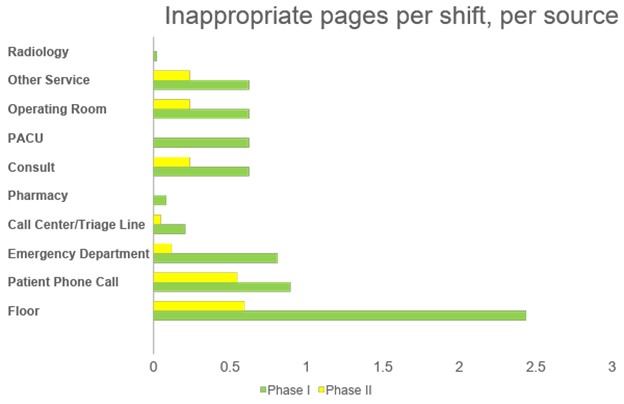Back
Introduction: Taking after-hours call is an important and necessary part of resident training, however this is a key source of burnout. In 2003, the ACGME implemented resident work hour restrictions, requiring programs to implement solutions to cover after-hours call burden without violating duty hour limits. Even with optimal sleep hygiene, overnight paging contributes to fatigue. We sought to decrease the number of inappropriate pages after-hours by 50% to promote resident sleep and decrease burnout.
Methods: Over 9 weeks, all after-hours pages to the on-call resident at the University of Minnesota Department of Urology were documented. Pages were deemed “appropriate” or “inappropriate” based on three independent reviewers. The source of each page was documented and three were chosen for implementation of interventions: the wards, the call triage center, patient phone calls. A single intervention was implemented for each source. We allowed a 6-week period for implementation of these interventions, then performed another 9-week data collection cycle for after-hours pages. We compared total number of pages and inappropriate pages across sources for each cycle.
Results: In phase I, 48 shifts were recorded. The mean number of pages per shift was 8.9 (range 1-27), with 52.7% of pages considered “inappropriate.” The most pages came from the wards (48.9%) followed by the emergency department (20.4%), patient phone calls (19.4%), and the call center (2.6%). From these domains, the call center had the highest proportion of inappropriate pages (90.9%), followed by the wards (56.0%), patient phone calls (51.8%), and the emergency department (44.8%). After implementation of our interventions, 42 shifts were recorded. The mean number of pages per shift decreased to 5.9 (range 1-20), and 25.0% of pages were deemed “inappropriate.” All domains saw a decrease in inappropriate after-hours pages (Figure 1).
Conclusions: By improving communication to nurses, call center personnel, and patients, inappropriate after-hours pages decreased by 52.6%. Future studies are needed to assess if resident burnout was impacted and if the impact was sustainable over time. SOURCE OF
Funding: None.

Podium Session
Session: PD30: Education Research II
PD30-11: Turning the page again: Decreasing inappropriate after-hours pages
Sunday, April 30, 2023
11:10 AM – 11:20 AM CST
Location: S502
.jpg)
Rachel A. Mann, MD, BS (she/her/hers)
University of Minnesota
Podium Presenter(s)
Introduction: Taking after-hours call is an important and necessary part of resident training, however this is a key source of burnout. In 2003, the ACGME implemented resident work hour restrictions, requiring programs to implement solutions to cover after-hours call burden without violating duty hour limits. Even with optimal sleep hygiene, overnight paging contributes to fatigue. We sought to decrease the number of inappropriate pages after-hours by 50% to promote resident sleep and decrease burnout.
Methods: Over 9 weeks, all after-hours pages to the on-call resident at the University of Minnesota Department of Urology were documented. Pages were deemed “appropriate” or “inappropriate” based on three independent reviewers. The source of each page was documented and three were chosen for implementation of interventions: the wards, the call triage center, patient phone calls. A single intervention was implemented for each source. We allowed a 6-week period for implementation of these interventions, then performed another 9-week data collection cycle for after-hours pages. We compared total number of pages and inappropriate pages across sources for each cycle.
Results: In phase I, 48 shifts were recorded. The mean number of pages per shift was 8.9 (range 1-27), with 52.7% of pages considered “inappropriate.” The most pages came from the wards (48.9%) followed by the emergency department (20.4%), patient phone calls (19.4%), and the call center (2.6%). From these domains, the call center had the highest proportion of inappropriate pages (90.9%), followed by the wards (56.0%), patient phone calls (51.8%), and the emergency department (44.8%). After implementation of our interventions, 42 shifts were recorded. The mean number of pages per shift decreased to 5.9 (range 1-20), and 25.0% of pages were deemed “inappropriate.” All domains saw a decrease in inappropriate after-hours pages (Figure 1).
Conclusions: By improving communication to nurses, call center personnel, and patients, inappropriate after-hours pages decreased by 52.6%. Future studies are needed to assess if resident burnout was impacted and if the impact was sustainable over time. SOURCE OF
Funding: None.

